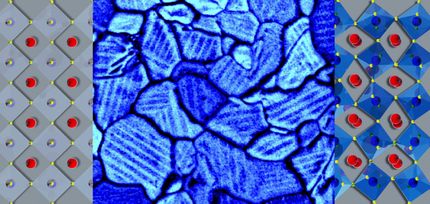Caltech-led team designs novel negative-index metamaterial that responds to visible light
Uniquely versatile material could be used for more efficient light collection in solar cells
A group of scientists led by researchers from the California Institute of Technology (Caltech) has engineered a type of artificial optical material—a metamaterial—with a particular three-dimensional structure such that light exhibits a negative index of refraction upon entering the material. In other words, this material bends light in the "wrong" direction from what normally would be expected, irrespective of the angle of the approaching light.
This new type of negative-index metamaterial (NIM), described in an advance online publication in the journal Nature Materials, is simpler than previous NIMs—requiring only a single functional layer—and yet more versatile, in that it can handle light with any polarization over a broad range of incident angles. And it can do all of this in the blue part of the visible spectrum, making it "the first negative index metamaterial to operate at visible frequencies," says graduate student Stanley Burgos, a researcher at the Light-Material Interactions in Energy Conversion Energy Frontier Research Center at Caltech and the paper's first author.
"By engineering a metamaterial with such properties, we are opening the door to such unusual—but potentially useful—phenomena as superlensing (high-resolution imaging past the diffraction limit), invisibility cloaking, and the synthesis of materials index-matched to air, for potential enhancement of light collection in solar cells," says Harry Atwater, Howard Hughes Professor and professor of applied physics and materials science, director of Caltech's Resnick Institute, founding member of the Kavli Nanoscience Institute, and leader of the research team
What makes this NIM unique, says Burgos, is its engineering. "The source of the negative-index response is fundamentally different from that of previous NIM designs," he explains. Those previous efforts used multiple layers of "resonant elements" to refract the light in this unusual way, while this version is composed of a single layer of silver permeated with "coupled plasmonic waveguide elements."
Surface plasmons are light waves coupled to waves of electrons at the interface between a metal and a dielectric (a non-conducting material like air). Plasmonic waveguide elements route these coupled waves through the material. Not only is this material more feasible to fabricate than those previously used, Burgos says, it also allows for simple "tuning" of the negative-index response; by changing the materials used, or the geometry of the waveguide, the NIM can be tuned to respond to a different wavelength of light coming from nearly any angle with any polarization. "By carefully engineering the coupling between such waveguide elements, it was possible to develop a material with a nearly isotopic refractive index tuned to operate at visible frequencies."
This sort of functional flexibility is critical if the material is to be used in a wide variety of ways, says Atwater. "For practical applications, it is very important for a material's response to be insensitive to both incidence angle and polarization," he says. "Take eyeglasses, for example. In order for them to properly focus light reflected off an object on the back of your eye, they must be able to accept and focus light coming from a broad range of angles, independent of polarization. Said another way, their response must be nearly isotropic. Our metamaterial has the same capabilities in terms of its response to incident light."
This means the new metamaterial is particularly well suited to use in solar cells, Atwater adds. "The fact that our NIM design is tunable means we could potentially tune its index response to better match the solar spectrum, allowing for the development of broadband wide-angle metamaterials that could enhance light collection in solar cells," he explains. "And the fact that the metamaterial has a wide-angle response is important because it means that it can 'accept' light from a broad range of angles. In the case of solar cells, this means more light collection and less reflected or 'wasted' light."
"This work stands out because, through careful engineering, greater simplicity has been achieved," says Ares Rosakis, chair of the Division of Engineering and Applied Science at Caltech and Theodore von Kármán Professor of Aeronautics and Mechanical Engineering.
Other news from the department science
Most read news
More news from our other portals
See the theme worlds for related content
Topic world Synthesis
Chemical synthesis is at the heart of modern chemistry and enables the targeted production of molecules with specific properties. By combining starting materials in defined reaction conditions, chemists can create a wide range of compounds, from simple molecules to complex active ingredients.

Topic world Synthesis
Chemical synthesis is at the heart of modern chemistry and enables the targeted production of molecules with specific properties. By combining starting materials in defined reaction conditions, chemists can create a wide range of compounds, from simple molecules to complex active ingredients.


























































